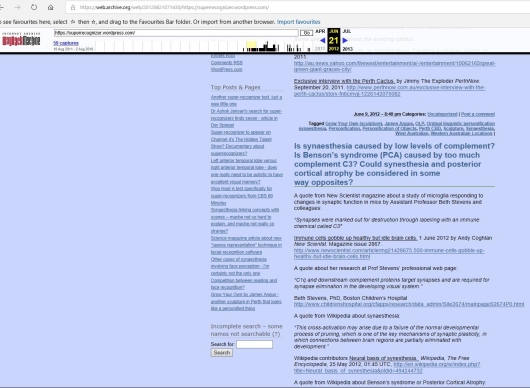A note of warning – If you are thinking about copying or plagiarizing any of the text, ideas or descriptions in this post and using it as your own work without giving me (C. Wright, author of the blog “Am I a Super-recognizer?”) the proper acknowledgement and citations, then think again. If you do that you will be found out and you will regret it. If you want to make reference to this post or any of the ideas in it make sure that you state in your work exactly where you first read about these ideas. If you wish to quote any text from this post be sure to cite this post at this blog properly. There are many established citation methods. If you quote or make reference to material in this blog in your work, it would be a common courtesy to let me know about your work (I’m interested!) in a comment on any of the posts in this blog. Thank you.

A quote from New Scientist magazine about a study of microglia responding to changes in synaptic function in mice by Assistant Professor Beth Stevens and colleagues:
“Synapses were marked out for destruction through labelling with an immune chemical called C3”
Immune cells gobble up healthy but idle brain cells. 1 June 2012 by Andy Coghlan New Scientst. Magazine issue 2867. http://www.newscientist.com/article/mg21428675.500-immune-cells-gobble-up-healthy-but-idle-brain-cells.html
A quote about her research at Prof Stevens’ professional web page:
“C1q and downstream complement proteins target synapses and are required for synapse elimination in the developing visual system.”
Beth Stevens, PhD, Boston Children’s Hospital http://www.childrenshospital.org/cfapps/research/data_admin/Site2674/mainpageS2674P0.html
A quote from Wikipedia about synaesthesia:
“This cross-activation may arise due to a failure of the normal developmental process of pruning, which is one of the key mechanisms of synaptic plasticity, in which connections between brain regions are partially eliminated with development.”
Wikipedia contributors Neural basis of synesthesia. Wikipedia, The Free Encyclopedia, 25 May 2012, 01:45 UTC, http://en.wikipedia.org/w/index.php?title=Neural_basis_of_synesthesia&oldid=494244732
A quote from Wikipedia about Benson’s syndrome or Posterior Cortical Atrophy:
“The disease causes atrophy of the back (posterior) part of the cerebral cortex, resulting in the progressive disruption of complex visual processing.“
Wikipedia contributors Posterior cortical atrophy Wikipedia, The Free Encyclopedia, 4 February 2012, 22:34 UTC, http://en.wikipedia.org/w/index.php?title=Posterior_cortical_atrophy&oldid=475033670
Two quotes by me from this blog:
“The idea that I have something like the opposite of Benson’s syndrome would neatly draw together all the elements of some odd phenomena that I have observed over a number of years…”
“I guess the million-dollar question is – why does Benson’s syndrome affect only some specific parts of the brain? What is it about a certain group of areas of the brain that appear to make these areas prone to hyperconnectivity in some families, and vulnerable to dysfunction in Benson’s syndrome? Is there some magic chemical or process that regulates growth in these areas of the brain? I doubt that the answer could be so simple.”
The Opposite of Benson’s Syndrome? by C. Wright Am I a Super-recognizer? January 4, 2011. https://superrecognizer.wordpress.com/2011/01/04/the-opposite-of-bensons-syndrome/
My doubt has suddenly evaporated! Could complement be the “magic chemical”? Where’s my Nobel Prize in Physiology or Medicine?
The DOI link in the New Scientist article discussed above doesn’t work, but I’m quite sure this is the journal paper that the article is about:
Dorothy P. Schafer, Emily K. Lehrman, Amanda G. Kautzman, Ryuta Koyama, Alan R. Mardinly, Ryo Yamasaki, Richard M. Ransohoff, Michael E. Greenberg, Ben A. Barres, Beth Stevens
Microglia Sculpt Postnatal Neural Circuits in an Activity and Complement-Dependent Manner. Neuron. Volume 74 Issue 4 691-705, 24 May 2012. 10.1016/j.neuron.2012.03.026
http://www.cell.com/neuron/retrieve/pii/S0896627312003340A number of other interesting journal papers can be found through Prof. Steven’s web page, some available to read in full text (if you can find the button to click on in the top right corner of the PubMed page). I also found a recently published item by Stevens and colleagues that looks like it is about the same subject as the New Scientist article, published in a conference abstract supplement of the journal Schizophrenia Research, which is a bit of a mystery as I didn’t think the title suggested schizophrenia. You need to pay to read the full text, which I didn’t. http://www.sciencedirect.com/science/article/pii/S0920996412700397
Here’s something else to read, if you’re keen. You can read the whole thing for free:
Marie-Ève Tremblay, Beth Stevens, Amanda Sierra, Hiroaki Wake, Alain Bessis and Axel Nimmerjahn The Role of Microglia in the Healthy Brain. Journal of Neuroscience. 9 November 2011, (45): 16064-16069; doi:10.1523/JNEUROSCI.4158-11.2011 http://www.jneurosci.org/content/31/45/16064.long

C3, C4, C5….






